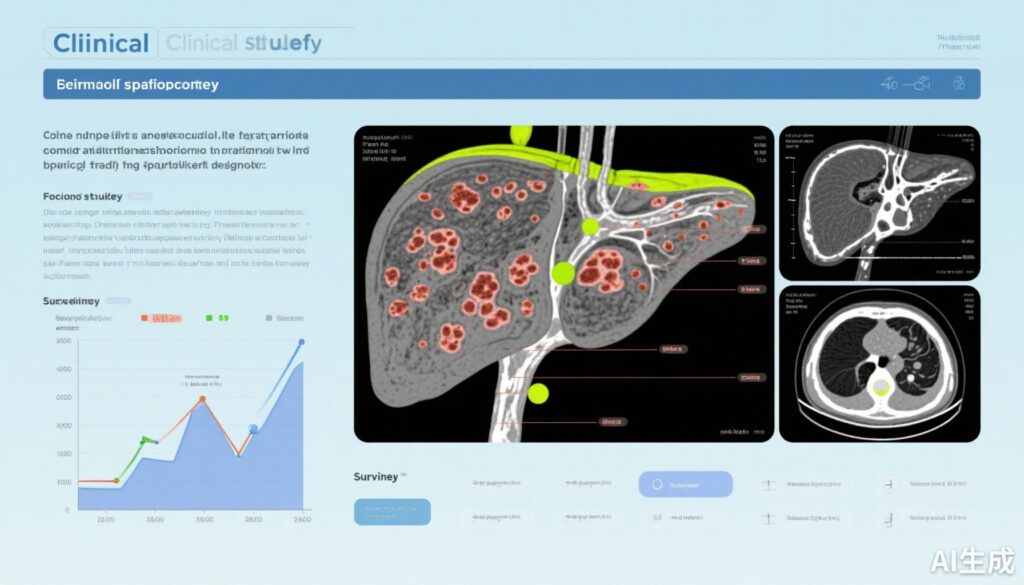Highlights
- This large prospective international study reveals that combined MRI and CT imaging modestly improves the assessment of nonviability in disappearing colorectal liver metastases (DLMs) but with limited negative predictive value (NPV).
- Confirmed disappearing liver metastases (cDLMs), defined by disappearance on both CT and MRI, still corresponded to viable disease in a substantial proportion of cases.
- No significant survival advantage was observed in patients with all cDLMs resected compared to those with cDLMs left in situ after R0/1 resection, questioning the necessity of aggressive management for all cDLMs.
Background
Colorectal cancer is among the most prevalent cancers globally, with the liver being the most common site for metastases. Approximately 20–30% of patients presenting with colorectal liver metastases (CLMs) have initially unresectable disease that may be downstaged by chemotherapy. The phenomenon of disappearing liver metastases (DLMs) occurs when lesions initially visible on imaging become undetectable after systemic therapy, primarily on computed tomography (CT).
The clinical conundrum is whether these DLMs represent complete pathological response or residual viable tumor. Current guidelines lack consensus on optimal management: whether to surgically resect the original lesion sites or to observe. Accurate imaging modalities to determine nonviability could prevent unnecessary surgery and related morbidities.
This unmet need has elevated interest in evaluating the diagnostic accuracy of imaging techniques—including multiparametric MRI combined with CT—to reliably predict tumor nonviability.
Key Content
Study Design and Population
The referenced study is a prospective international cohort involving 21 centers across France, Austria, Belgium, the US, and Japan. It enrolled 112 patients (from 233 registered) with initially unresectable CLMs downstaged after chemotherapy, ensuring a minimum 2-year follow-up period.
Imaging Modalities and Definitions
Participants underwent postchemotherapy evaluation using both CT and multiparametric MRI sequences—including diffusion-weighted imaging, T1/T2-weighted imaging, and contrast-enhanced phases. DLMs were defined by disappearance of lesions on CT imaging, while confirmed DLMs (cDLMs) required disappearance on both CT and MRI.
Primary Endpoint and Statistical Considerations
The prespecified primary endpoint was the negative predictive value (NPV) of combined MRI and CT in confirming nonviability of cDLMs. Nonviability was validated by pathological complete response for resected lesions or absence of recurrence at cDLM sites over a 2-year surveillance period when lesions were left unresected. The sample size calculation aimed for 149 evaluable cDLMs to exclude an NPV ≤0.85 with 90% power.
Main Findings
Across 112 patients (mean age 60 years; 60% male), 152 cDLMs and 227 DLMs were evaluable. The overall NPV of cDLMs for nonviability was 62.5% (95/152; 90% CI 50.8%–74.2%), markedly below the targeted threshold. By contrast, the NPV for DLMs alone was lower (52.9%).
Comparisons revealed an NPV of 56.8% for resected cDLMs and 70.3% for those left behind. Importantly, in patients without extrahepatic disease who underwent R0/1 resection, disease-free survival (DFS) and overall survival (OS) were similar between groups with all cDLMs removed versus those with at least one cDLM unresected.
Comparison with Previous Literature
Earlier retrospective studies and smaller cohorts have variably reported NPVs ranging widely for CT and MRI in evaluating liver metastasis response. The current study—being prospective and multicenter—provides more robust evidence. Previous meta-analyses suggest MRI, especially with hepatocyte-specific contrast agents, improves detection sensitivity of residual disease but do not fully resolve the challenge of confirming complete pathological remission.
The study aligns somewhat with prior findings that disappearance on imaging does not necessarily equate to pathological cure, underscoring persistent microscopic disease risk.
Translational and Clinical Implications
The findings emphasize that combined imaging enhances but does not definitively confirm nonviability of DLMs. Consequently, surgical decisions should consider that cDLMs may harbor residual viable cancer cells. However, the lack of adverse survival outcomes when some cDLMs are left behind after curative-intent resection invites a reconsideration of aggressive surgical strategies to remove all radiologically occult lesions.
Improved imaging biomarkers or molecular techniques may be necessary to resolve this diagnostic uncertainty. Moreover, this evidence supports individualized treatment planning balancing risks of overtreatment against potential residual tumor progression.
Expert Commentary
Despite advances, reliable noninvasive confirmation of complete pathological response remains elusive. Possible reasons include limited spatial resolution, heterogeneous tumor biology, and fibrotic residues mimicking complete response.
The combination of advanced MRI techniques and high-resolution CT constitutes best available imaging currently; however, intrinsic limitations in detecting microscopic residual disease persist.
Clinical guidelines differ regionally—some recommending resection of all initial metastases sites regardless of imaging changes, others favoring careful observation when lesions disappear post-chemotherapy. This study’s findings may prompt reconsideration, particularly given the similar survival outcomes with unresected cDLMs in select patients.
Future research should focus on integrating functional imaging modalities—such as PET/MRI with novel tracers—and liquid biopsy markers to better predict pathological status. Additionally, tailored surveillance protocols and risk stratification strategies should be developed.
Conclusions
The international prospective study by Kataoka et al. reveals that while combined MRI and CT improves assessment accuracy for nonviability in disappearing colorectal liver metastases, confirmed DLMs still often represent viable residual tumor. The therapeutic benefit of surgically removing all cDLMs after downstaging remains uncertain, especially in patients with localized disease achieving R0/1 resection. This underscores a critical gap in diagnostic precision and indicates the need for advanced diagnostic technologies and personalized management strategies.
References
- Kataoka K, Mauer M, Shiozawa M, et al. Diagnostic Accuracy of Imaging in Assessing Nonviability of Disappearing Colorectal Liver Metastasis. JAMA Surg. 2025 Sep 17:e253600. doi:10.1001/jamasurg.2025.3600. PMID: 40960802; PMCID: PMC12444651.
- Van Kessel CS, van den Tol P, Puijk RS, et al. MRI and CT imaging characteristics and detection rates of colorectal liver metastases after systemic chemotherapy: A meta-analysis. European Journal of Radiology. 2019;119:108615. doi:10.1016/j.ejrad.2019.108615
- Adam R, Pascal G, Castaing D, et al. Long-term outcomes following downstaging of colorectal liver metastases. J Clin Oncol. 2012;30(2):213–219. doi:10.1200/JCO.2011.35.3249
- Van den Eynde M, Meunier B, Bachet JB, et al. Optimal surgical management of disappearing liver metastases: A systematic review. Eur J Surg Oncol. 2020;46(1):23-29. doi:10.1016/j.ejso.2019.09.006



